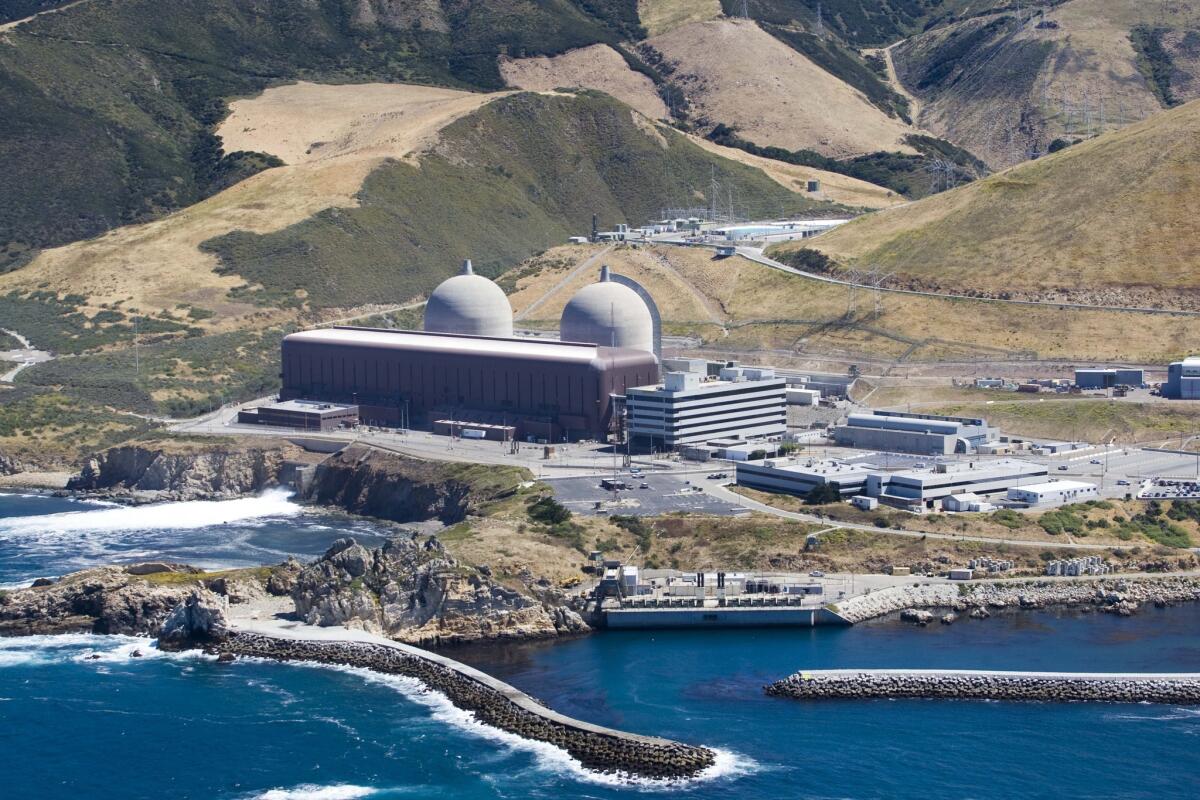Editorial: Closing California’s last nuclear plant is welcome, so long as it doesn’t hamper the state’s climate change goals

- Share via
The announcement this week by Pacific Gas & Electric Co. that it will shut down the state’s last nuclear power plant by 2025 and replace the energy it generated with renewable power is good news for Californians, who have always had an uneasy relationship with nuclear power in general, and with the Diablo Canyon Power Plant in particular.
Few will be sorry to see the reactors near Avila Beach — uncomfortably close to several earthquake fault lines — go dark. But this will be a victory only if the utility can follow through on its promise to replace the lost nuclear power without turning to fossil fuels. Regulators and lawmakers must closely examine the terms of the shutdown deal (which PG&E worked out with the electrical workers union and environmental groups) and ensure it won’t endanger the state’s ambitious goals of reducing greenhouse gas emissions.
Gov. Jerry Brown’s climate change legacy will be put at risk if the closing of Diablo Canyon leads to an increase in the use of fossil fuels.
For all its potential for meltdown disaster, nuclear power is “clean” and sustainable. Diablo Canyon, which began operation in 1985, produces about 20% of the electricity that PG&E provides to its customers in Central and Northern California. That’s a lot of electricity to replace, or to save through conservation. Doing so even with a nine-year head start to identify new power sources will be tricky. For one thing, it will require storage systems for renewable energy that are a still-developing technology. While there’s reason for optimism that the capability will be there in 2025 — and while PG&E’s promise will create further incentives for companies to come up with such new technologies — for now the issue remains a possible stumbling block.
There is a faction of the environmental community, albeit a small one, that believes turning away from nuclear power is a mistake. There’s no way, they say, that the power from nuclear plants can be replaced without using fossil fuels. Indeed, when other nuclear plants have shut down natural gas usage has often increased, they say. That’s bad because not only is gas a fossil fuel, but it can be dangerous as well. A ruptured gas line was responsible for the deadly San Bruno explosion and the massive gas leak at the Aliso Canyon storage facility that began last year and released about 100,000 tons of methane gas into the atmosphere. Simply swapping nuclear power for natural gas is not a solution. Gov. Jerry Brown’s climate change legacy will be put at risk if the closing of Diablo Canyon leads to an increase in the use of fossil fuels.
An orderly and planned closure such as this one is certainly preferable to an unexpected shutdown after something goes wrong, as was the case at the San Onofre Nuclear Generating Station in Northern San Diego County in 2013. Southern California Edison and the other owners of the plant decided to shutter the plant after steam generators failed.
The end of California’s nuclear age may have been inevitable. The public has never been completely comfortable with the risk posed by nuclear power plants, and after the 2011 disaster at the Fukushima Daiichi nuclear plant in Japan, the concerns about California’s coastal nuclear plants only intensified.
That there have been no significant accidents at the state’s nuclear plants over the course of about a half a century is fortunate, but it’s no reason to continue relying on a power source that has the potential for massive catastrophe. If the closing of Diablo Canyon’s nuclear reactors can be accomplished by simply shifting to sustainable and safer green energy sources, there’s no reason not to do so. Indeed, a smart, organized transition could provide a blueprint for other states that want to retire nuclear plants.
Follow the Opinion section on Twitter @latimesopinion and Facebook
A cure for the common opinion
Get thought-provoking perspectives with our weekly newsletter.
You may occasionally receive promotional content from the Los Angeles Times.



